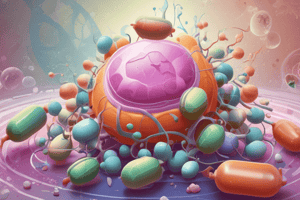Podcast
Questions and Answers
What is the primary mechanism of action of trifluridine?
What is the primary mechanism of action of trifluridine?
- Inhibition of viral DNA synthesis (correct)
- Stimulation of viral DNA synthesis
- Enhancement of viral replication
- Inhibition of viral RNA synthesis
What is the significance of the trifluoromethyl group in trifluridine?
What is the significance of the trifluoromethyl group in trifluridine?
- It is responsible for the antiviral activity of trifluridine
- It decreases the van der Waals radius of the pyrimidine ring
- It increases the van der Waals radius of the pyrimidine ring
- It replaces the iodine atom at the 5-position of the pyrimidine ring (correct)
What is the advantage of acyclovir over other antiviral agents?
What is the advantage of acyclovir over other antiviral agents?
- It is effective against a broad range of viruses
- It is a true nucleoside
- It is most active against HSV type 2
- Uninfected human cells are unaffected by the drug (correct)
What is the primary indication for the use of trifluridine?
What is the primary indication for the use of trifluridine?
What is unique about the group attached to the base in acyclovir?
What is unique about the group attached to the base in acyclovir?
What is the primary function of idoxuridine in the viral DNA synthesis?
What is the primary function of idoxuridine in the viral DNA synthesis?
What is the mechanism of action of cytarabine in blocking viral DNA replication?
What is the mechanism of action of cytarabine in blocking viral DNA replication?
Which of the following cells is NOT responsible for producing interferon-α?
Which of the following cells is NOT responsible for producing interferon-α?
What is the primary use of cytarabine?
What is the primary use of cytarabine?
What is the result of the transcription of iodinated DNA?
What is the result of the transcription of iodinated DNA?
Flashcards are hidden until you start studying
Study Notes
Interferon-α and β
- Produced by lymphocytes and macrophages (interferon-α) and fibroblast and epithelial cells (interferon-β)
Idoxuridine
- Mechanism of action involves phosphorylation at O-5 by viral thymidylate kinase to yield a monophosphate
- Undergoes biotransformation to a triphosphate, which inhibits viral DNA synthesis and facilitates faulty transcription
- Altered DNA leads to miscoding errors in RNA and faulty protein synthesis
Cytarabine
- A pyrimidine nucleoside drug related to idoxuridine
- Used primarily as an anticancer agent for Burkitt lymphoma and myeloid and lymphatic leukemias
- Blocks cellular utilization of deoxycytidine, inhibiting viral DNA replication
- Converted to monophosphates, diphosphates, and triphosphates, which block DNA polymerase and C-2 reductase
- Used topically to treat herpes zoster (shingles), herpetic keratitis, and viral infections that resist idoxuridine
- Toxicity affects bone marrow, GI tract, and kidneys
Trifluridine
- A fluorinated pyrimidine nucleoside with in vitro inhibitory activity against HSV-1, HSV-2, CMV, vaccinia, and some adenoviruses
- Possesses a trifluoromethyl group instead of an iodine atom at the 5-position of the pyrimidine ring
- Inhibits viral DNA synthesis by interfering with thymidylate synthetase and incorporating into viral and cellular DNA
- Approved in the United States for treating primary keratoconjunctivitis and recurrent epithelial keratitis caused by HSV types 1 and 2
- Topical trifluridine shows efficacy in acyclovir-resistant HSV cutaneous infections
- Solutions are heat-sensitive and require refrigeration
Acyclovir
- An acyclic nucleoside with antiviral activity against herpesviruses
- Most effective against HSV type 1, less effective against HSV type 2, and least effective against VZV
- Uninfected human cells are unaffected by the drug
- Inhibits viral DNA synthesis by inhibiting DNA polymerase and incorporating into viral DNA
Studying That Suits You
Use AI to generate personalized quizzes and flashcards to suit your learning preferences.




